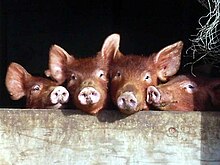Tamworth pig

Tamworth piglets
|
|
| Conservation status | Vulnerable |
|---|---|
| Country of origin | United Kingdom |
| Traits | |
|
|
The Tamworth is a breed of domestic pig originating in Tamworth, United Kingdom, with input from Irish pigs. It is among the oldest of pig breeds, but as with many older breeds of livestock, it is not well suited to modern production methods and is listed as "Threatened" in the United States and "Vulnerable" in the UK by the Rare Breeds Survival Trust, as fewer than 300 registered breeding females remain. This animal is of ginger to red colouration and is thought to have descended from wild boars, via native pig stock of Europe. Principal populations today are in the United Kingdom, Australia, the United States, New Zealand, and Canada. Alternate names for this animal are Sandy Back, and Tam.
This breed exhibits an elongated head shape and a long, narrow body. The ears are erect and pointed, while the face has rectilinear lines as well as the snout. Colours range from a pale gingery to dark mahogany red. Early in the breed history, colours were orange and purple, but breeding has been conducted to remove the orange colouration. The bristle density protects their skin from ultraviolet harm from the sun; nevertheless, when they moult between June and August (in the Northern Hemisphere), shade is sought along with copious mud coating to prevent sunburn. The mud coating also provides a way for the pigs to cool down, as pigs cannot sweat.
Tamworths are considered a medium-sized porcine breed, with a full-grown boar ranging from 250 to 370 kg (550 to 820 lb) and the mature sow from 200 to 300 kg (440 to 660 lb). The adult length ranges from 100 to 140 cm (39 to 55 in) and heights of about 50 to 65 cm (20 to 26 in) are common. The curled adult tail is about 24 to 30 cm (9.4 to 12 in). This animal is characterised by having a neck and legs that are long, and by deep sides, but narrow backs. Its ham structures are quite muscular and firm. The breed is also known for having excellent foot structure and a good skeletal system. Litter sizes are typically somewhat smaller than commercial breeds. Unacceptable features according to breed aficionados are: curly hair, coarse , turned up nose, and dark spots on the coat.
...
Wikipedia
